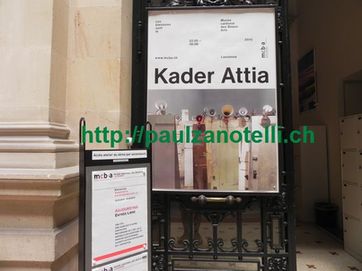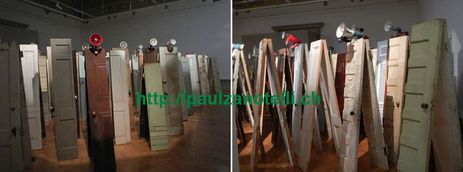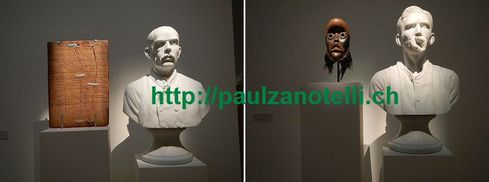 |
‘The horror! The horror!’, Heart of Darkness, Joseph Conrad, 1902Why would anyone want to go to a museum of fine arts on a Saturday afternoon when the temperature was as high as 35 degrees Celsius? One would have thought that the swimming pool or the lake would be the best places to go to on such a day, no? Well, part of the answer was that I was indeed hoping to enjoy some shade and, as such, I expected Palais de Rumine (an elegant Italianate building dating back to the nineteenth century) to provide some respite from the sweltering heat that could be felt out in the open. The other reason was that it was the first Saturday of the month and, here in Lausanne, museums owned by the state let you go in free of charge on that date. As I wanted a change from my reading or writing, I thought that going on foot to some of my favourite museums here in Lausanne would give me my dose of weekly physical exercise as well as some intellectual stimulation, but one for which the senses play a far more active role than, say, either reading or writing. I therefore decided to make my way to La Riponne passing by the pleasant surroundings of another favourite museum of mine, l'Hermitage. |
As mentioned above, my first port of call was Lausanne's Museum of Fine Arts. I usually enjoy the exhibitions that the curators put up for us there (at what must be the oldest institution for the visual arts in that city), as the museum pursues a good balance between modernist, contemporary and new art as well as it does not shy away from putting on display local artists, dead or still alive. Although the work of Kader Attia, a French citizen born to Algerian parents in the greater Paris region close to half a century ago and who divides his life between Berlin and Algiers (in addition to having lived in Congo and Venezuela), has been presented at some major exhibitions (Biennale de Lyon, Documenta, etc.), I knew nothing about his work and I was therefore eager to discover this artist through the exhibition ‘The wounds are here’ (22nd May until 30th August 2015).
| Mind those
megaphones The second room plays with the almost innate tendency humans have to feel claustrophobic whenever they find themselves in a room encumbered with objects or people. In this case, a series of fifty or so strange constructs – pieces of doors put together like stands, the door knobs facing the viewer and a megaphone perched on some of these menacing doors – seem to be marching towards the visitor in quasi military formation! To me this installation, called ‘Asesinos! Asesinos!’ (which sounds very much like ‘asinus’, donkey in Latin), represents the overwhelming power of discursive constructs, which are false doors and, unlike real doors, thus lead to nowhere because they are basically turned inwards, not towards the other (i.e. they are self-reflexive as opposed to being inclusive). |
 |

 |
On
scars, stitches and staples The third room consists of a series of six marble-like busts of men in the fashion of nineteenth century sculpture flanked by African masks or artefacts from the Middle East with artificial limbs arranged in a circle (the end part, the ‘feet’, only a few centimetres apart) in the middle of the room (‘Artificial nature’, 2014). My initial bafflement was reinforced upon inspection of the busts (‘Repair, culture's agency’, 2014). The faces of these men seemed to have been disfigured by strange scars or by what could have been some abnormal tissue growth; some of the scars appear to have been stitched. The same applies to some of the artefacts, which sport thick and sturdy-looking staples. ‘Strange, these juxtapositions of European and Middle-Eastern or African artefacts. And why are there staples on this stela?’, I thought to myself, ‘I don't understand what the artist is trying to convey here’. |

 |
Edward
Said's ‘Orientalism’
(1978) revisited: ‘The
culture of fear, an invention of evil’ (2013) The fourth room is quite similar to the second in its intention to inflict unease upon the visitor. However, the visitor here is more likely to feel a sense of oppression given the number of metal shelves (a wall of them almost ceiling high) standing right in front of him/her, with only a few passages available – either in between the units or at the sides. For fear of damaging any of the items on display (mainly cuttings from nineteenth century magazines glorifying the colonial adventure and books or magazine covers analysing radical Islamism or even mainstream Islam in the context of the attacks of 11th September 2001 and the events that unfolded subsequently), the visitor is unlikely to wander through many of the shelves; from what I have seen, he or she will rather look at some items on one or two shelves and quickly head for one of the ‘aisles’. The visitor might therefore appear to be avoiding confrontation with the critique of European nineteenth century colonial propaganda presented on the shelves which, according to Kader Attia, has not only resurfaced recently but is in fact recycling some of the same racist clichés to portray the ‘other’ (who is now the Muslim in the iconography of mainstream Western media, according to this installation). Although I disagreed with some of the conclusions to be made from the items on display, or with some of the artist’s more contentious claims (e.g. that there is ‘a white man saving a coloured girl’ topos at play in the media nowadays), I could not help but react in a quasi Conradian fashion, muttering to myself ‘The horror! The horror of it all!’. |
End of
Part 1, to be continued – Part 2 will provide a twist (yes, an
ironic twist) to the Conrad quotation. ;-)
Lausanne, 9th July 2015

